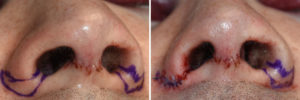The width of the nostrils is the only soft tissue aspect of the nose that can be surgically altered through tissue removal. The base of the nostril contains neither cartilage or bone. It has only fibrofatty tissue and skin. This is unlike all other rhinoplasty maneuvers that add or subtract tissue rom the existing osteocartilaginous support. By which external skin adaptation allows the shape of the nose to reflect those changes.
Nostril modification to change either their width, length or both is done through wedge soft tissue excision. The orientation of that wedge excision determines how the nostril shape is altered. An internal wedge, the most common technique used in many rhinoplasties, is oriented along the internal alar-sill junction. By so doing the width of the nostrils is reduced by an inward movement. The typical amount is in the 4mm range which creates less bialar width reduction than the additive numbers would suggest. It is virtually scarless given the excision location.

The indications for a more complete nostril reshaping through width and length reduction often exist in the low projecting tip where the midline length of the columella appears short compared to the length of the sides. (nostrils) I would not go so far as to say the basal view of the nose should look like an equilateral triangle. But the midline columellar length should ideally be equal to or only slight less than the length of the sides.
Dr. Barry Eppley
Indianapolis, Indiana




